GSM London ACSK4001: Academic Skills Portfolio Autumn 17
VerifiedAdded on 2023/06/16
|28
|6221
|416
Portfolio
AI Summary
This Academic Skills Portfolio (ACSK4001) from Autumn 2017 includes self-evaluation checklists, a personal SWOT analysis, and tasks related to structuring writing, quantitative data analysis, evaluating sources, synthesizing information, and presenting assignments. It features a written analysis of data concerning the impact of the UK's exit from the European Union, along with reflective writing on personal development. The portfolio also incorporates editing, proofreading, and a post-presentation reflection. The document also includes tasks related to academic writing and a personal development plan, aimed at improving academic and professional skills. It provides a comprehensive overview of academic literacy and personal development within the context of higher education, focusing on critical thinking, self-analysis, and the application of relevant technologies.
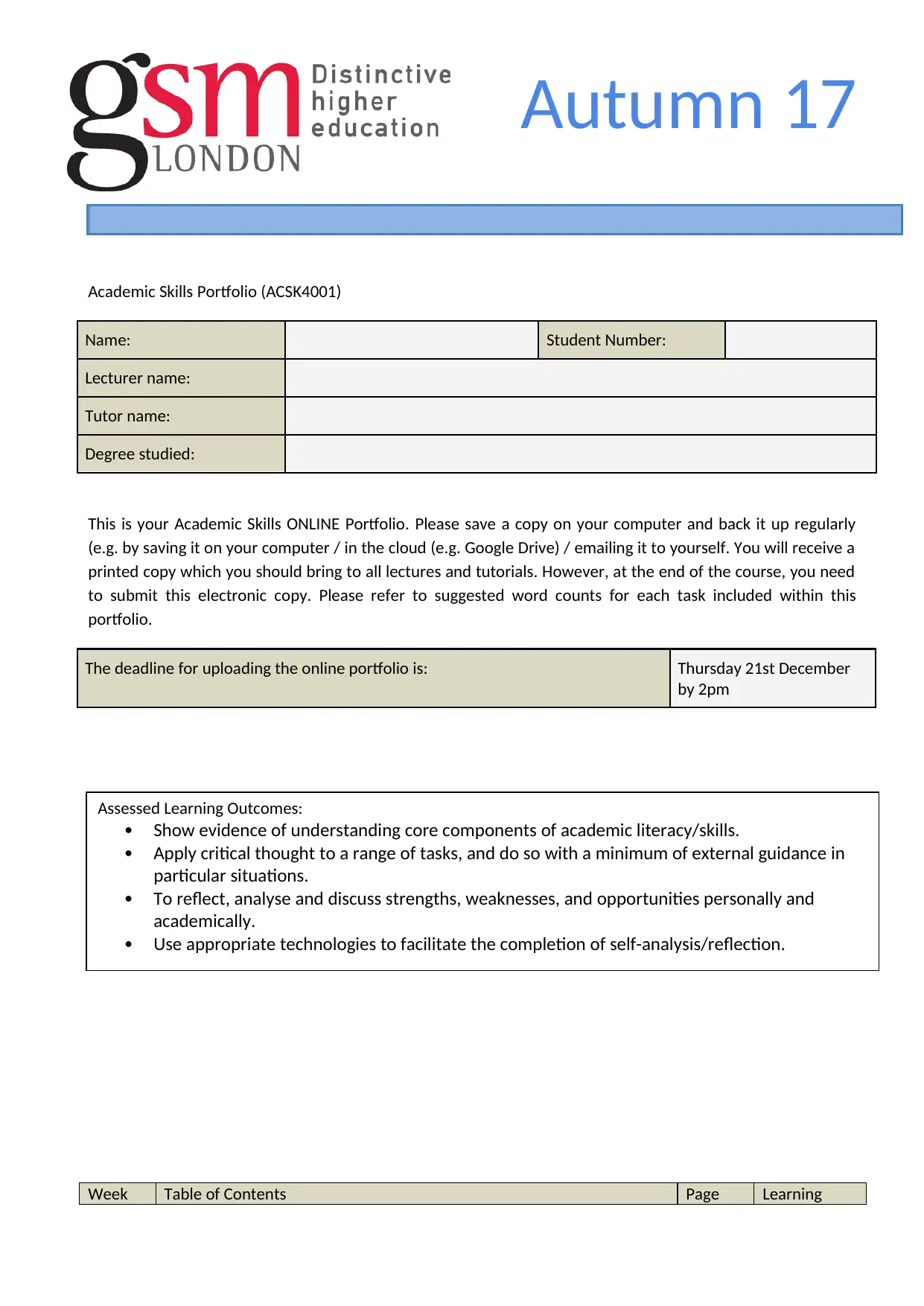
Autumn 17
Academic Skills Portfolio (ACSK4001)
Name: Student Number:
Lecturer name:
Tutor name:
Degree studied:
This is your Academic Skills ONLINE Portfolio. Please save a copy on your computer and back it up regularly
(e.g. by saving it on your computer / in the cloud (e.g. Google Drive) / emailing it to yourself. You will receive a
printed copy which you should bring to all lectures and tutorials. However, at the end of the course, you need
to submit this electronic copy. Please refer to suggested word counts for each task included within this
portfolio.
The deadline for uploading the online portfolio is: Thursday 21st December
by 2pm
Week Table of Contents Page Learning
Assessed Learning Outcomes:
Show evidence of understanding core components of academic literacy/skills.
Apply critical thought to a range of tasks, and do so with a minimum of external guidance in
particular situations.
To reflect, analyse and discuss strengths, weaknesses, and opportunities personally and
academically.
Use appropriate technologies to facilitate the completion of self-analysis/reflection.
Academic Skills Portfolio (ACSK4001)
Name: Student Number:
Lecturer name:
Tutor name:
Degree studied:
This is your Academic Skills ONLINE Portfolio. Please save a copy on your computer and back it up regularly
(e.g. by saving it on your computer / in the cloud (e.g. Google Drive) / emailing it to yourself. You will receive a
printed copy which you should bring to all lectures and tutorials. However, at the end of the course, you need
to submit this electronic copy. Please refer to suggested word counts for each task included within this
portfolio.
The deadline for uploading the online portfolio is: Thursday 21st December
by 2pm
Week Table of Contents Page Learning
Assessed Learning Outcomes:
Show evidence of understanding core components of academic literacy/skills.
Apply critical thought to a range of tasks, and do so with a minimum of external guidance in
particular situations.
To reflect, analyse and discuss strengths, weaknesses, and opportunities personally and
academically.
Use appropriate technologies to facilitate the completion of self-analysis/reflection.
Paraphrase This Document
Need a fresh take? Get an instant paraphrase of this document with our AI Paraphraser
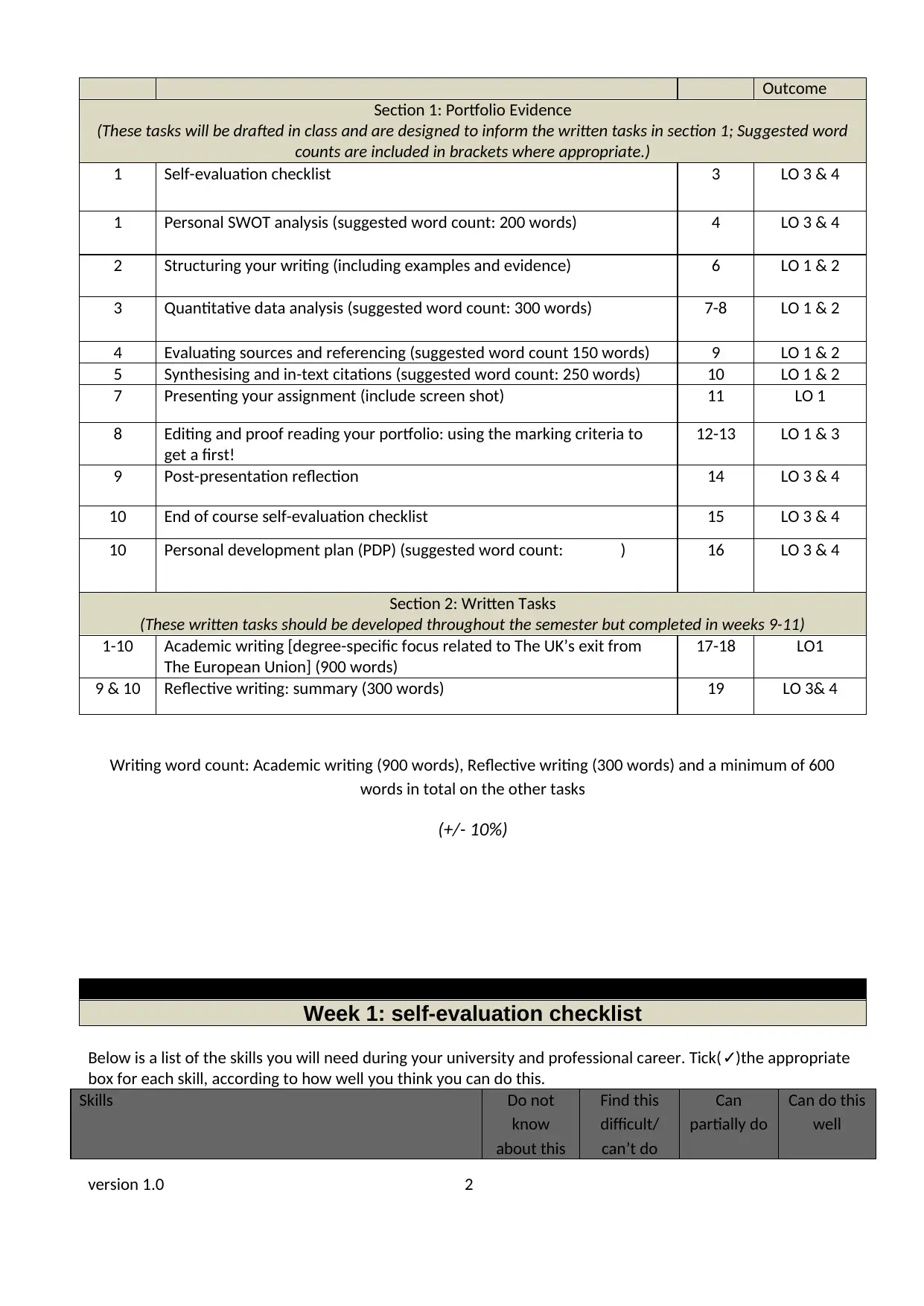
Outcome
Section 1: Portfolio Evidence
(These tasks will be drafted in class and are designed to inform the written tasks in section 1; Suggested word
counts are included in brackets where appropriate.)
1 Self-evaluation checklist 3 LO 3 & 4
1 Personal SWOT analysis (suggested word count: 200 words) 4 LO 3 & 4
2 Structuring your writing (including examples and evidence) 6 LO 1 & 2
3 Quantitative data analysis (suggested word count: 300 words) 7-8 LO 1 & 2
4 Evaluating sources and referencing (suggested word count 150 words) 9 LO 1 & 2
5 Synthesising and in-text citations (suggested word count: 250 words) 10 LO 1 & 2
7 Presenting your assignment (include screen shot) 11 LO 1
8 Editing and proof reading your portfolio: using the marking criteria to
get a first!
12-13 LO 1 & 3
9 Post-presentation reflection 14 LO 3 & 4
10 End of course self-evaluation checklist 15 LO 3 & 4
10 Personal development plan (PDP) (suggested word count: ) 16 LO 3 & 4
Section 2: Written Tasks
(These written tasks should be developed throughout the semester but completed in weeks 9-11)
1-10 Academic writing [degree-specific focus related to The UK’s exit from
The European Union] (900 words)
17-18 LO1
9 & 10 Reflective writing: summary (300 words) 19 LO 3& 4
Writing word count: Academic writing (900 words), Reflective writing (300 words) and a minimum of 600
words in total on the other tasks
(+/- 10%)
SECTION 1: PORTFOLIO EVIDENCE
Week 1: self-evaluation checklist
Below is a list of the skills you will need during your university and professional career. Tick( )the appropriate✓
box for each skill, according to how well you think you can do this.
Skills Do not
know
about this
Find this
difficult/
can’t do
Can
partially do
Can do this
well
version 1.0 2
Section 1: Portfolio Evidence
(These tasks will be drafted in class and are designed to inform the written tasks in section 1; Suggested word
counts are included in brackets where appropriate.)
1 Self-evaluation checklist 3 LO 3 & 4
1 Personal SWOT analysis (suggested word count: 200 words) 4 LO 3 & 4
2 Structuring your writing (including examples and evidence) 6 LO 1 & 2
3 Quantitative data analysis (suggested word count: 300 words) 7-8 LO 1 & 2
4 Evaluating sources and referencing (suggested word count 150 words) 9 LO 1 & 2
5 Synthesising and in-text citations (suggested word count: 250 words) 10 LO 1 & 2
7 Presenting your assignment (include screen shot) 11 LO 1
8 Editing and proof reading your portfolio: using the marking criteria to
get a first!
12-13 LO 1 & 3
9 Post-presentation reflection 14 LO 3 & 4
10 End of course self-evaluation checklist 15 LO 3 & 4
10 Personal development plan (PDP) (suggested word count: ) 16 LO 3 & 4
Section 2: Written Tasks
(These written tasks should be developed throughout the semester but completed in weeks 9-11)
1-10 Academic writing [degree-specific focus related to The UK’s exit from
The European Union] (900 words)
17-18 LO1
9 & 10 Reflective writing: summary (300 words) 19 LO 3& 4
Writing word count: Academic writing (900 words), Reflective writing (300 words) and a minimum of 600
words in total on the other tasks
(+/- 10%)
SECTION 1: PORTFOLIO EVIDENCE
Week 1: self-evaluation checklist
Below is a list of the skills you will need during your university and professional career. Tick( )the appropriate✓
box for each skill, according to how well you think you can do this.
Skills Do not
know
about this
Find this
difficult/
can’t do
Can
partially do
Can do this
well
version 1.0 2
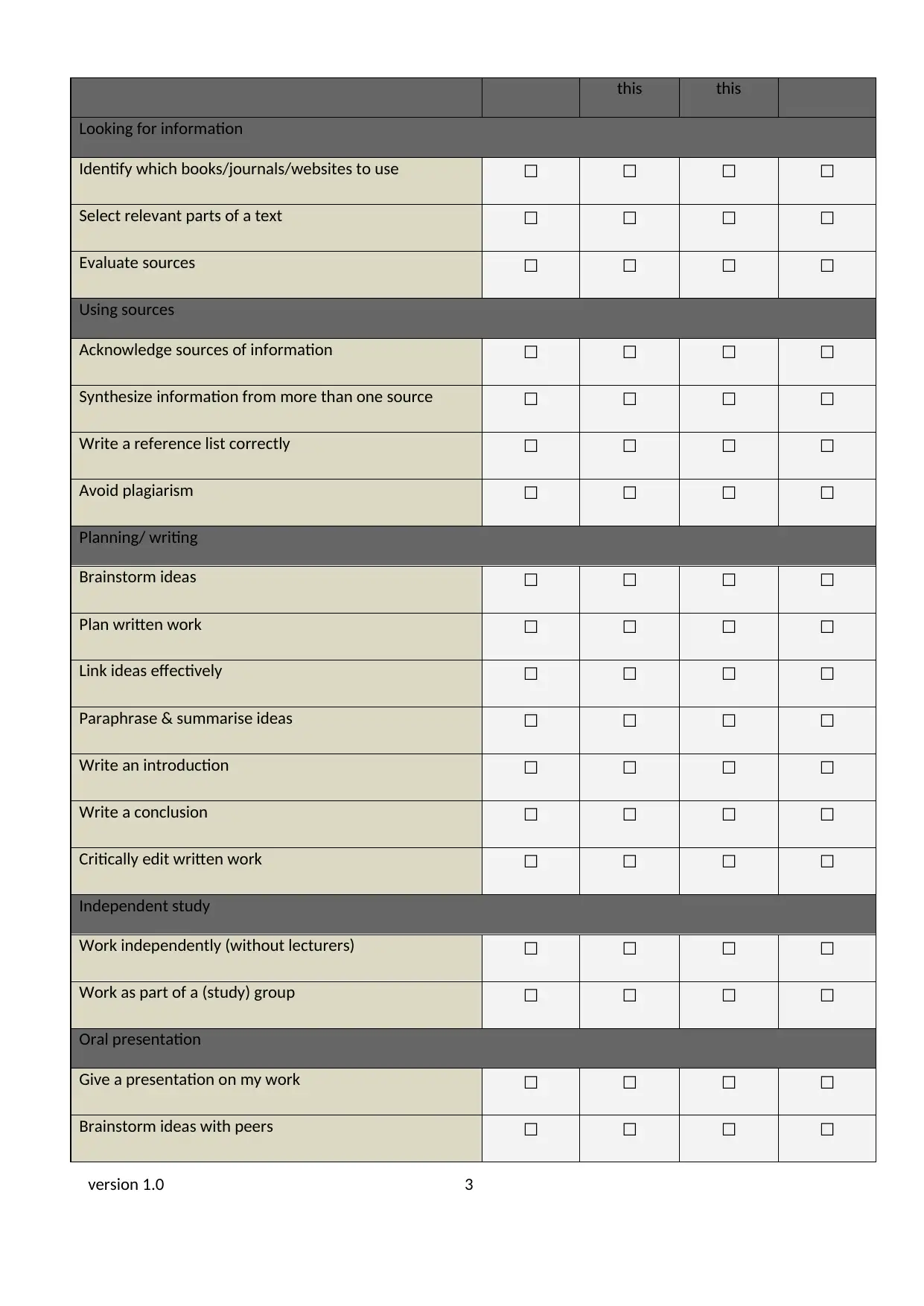
this this
Looking for information
Identify which books/journals/websites to use ☐ ☐ ☐ ☐
Select relevant parts of a text ☐ ☐ ☐ ☐
Evaluate sources ☐ ☐ ☐ ☐
Using sources
Acknowledge sources of information ☐ ☐ ☐ ☐
Synthesize information from more than one source ☐ ☐ ☐ ☐
Write a reference list correctly ☐ ☐ ☐ ☐
Avoid plagiarism ☐ ☐ ☐ ☐
Planning/ writing
Brainstorm ideas ☐ ☐ ☐ ☐
Plan written work ☐ ☐ ☐ ☐
Link ideas effectively ☐ ☐ ☐ ☐
Paraphrase & summarise ideas ☐ ☐ ☐ ☐
Write an introduction ☐ ☐ ☐ ☐
Write a conclusion ☐ ☐ ☐ ☐
Critically edit written work ☐ ☐ ☐ ☐
Independent study
Work independently (without lecturers) ☐ ☐ ☐ ☐
Work as part of a (study) group ☐ ☐ ☐ ☐
Oral presentation
Give a presentation on my work ☐ ☐ ☐ ☐
Brainstorm ideas with peers ☐ ☐ ☐ ☐
version 1.0 3
Looking for information
Identify which books/journals/websites to use ☐ ☐ ☐ ☐
Select relevant parts of a text ☐ ☐ ☐ ☐
Evaluate sources ☐ ☐ ☐ ☐
Using sources
Acknowledge sources of information ☐ ☐ ☐ ☐
Synthesize information from more than one source ☐ ☐ ☐ ☐
Write a reference list correctly ☐ ☐ ☐ ☐
Avoid plagiarism ☐ ☐ ☐ ☐
Planning/ writing
Brainstorm ideas ☐ ☐ ☐ ☐
Plan written work ☐ ☐ ☐ ☐
Link ideas effectively ☐ ☐ ☐ ☐
Paraphrase & summarise ideas ☐ ☐ ☐ ☐
Write an introduction ☐ ☐ ☐ ☐
Write a conclusion ☐ ☐ ☐ ☐
Critically edit written work ☐ ☐ ☐ ☐
Independent study
Work independently (without lecturers) ☐ ☐ ☐ ☐
Work as part of a (study) group ☐ ☐ ☐ ☐
Oral presentation
Give a presentation on my work ☐ ☐ ☐ ☐
Brainstorm ideas with peers ☐ ☐ ☐ ☐
version 1.0 3
⊘ This is a preview!⊘
Do you want full access?
Subscribe today to unlock all pages.

Trusted by 1+ million students worldwide
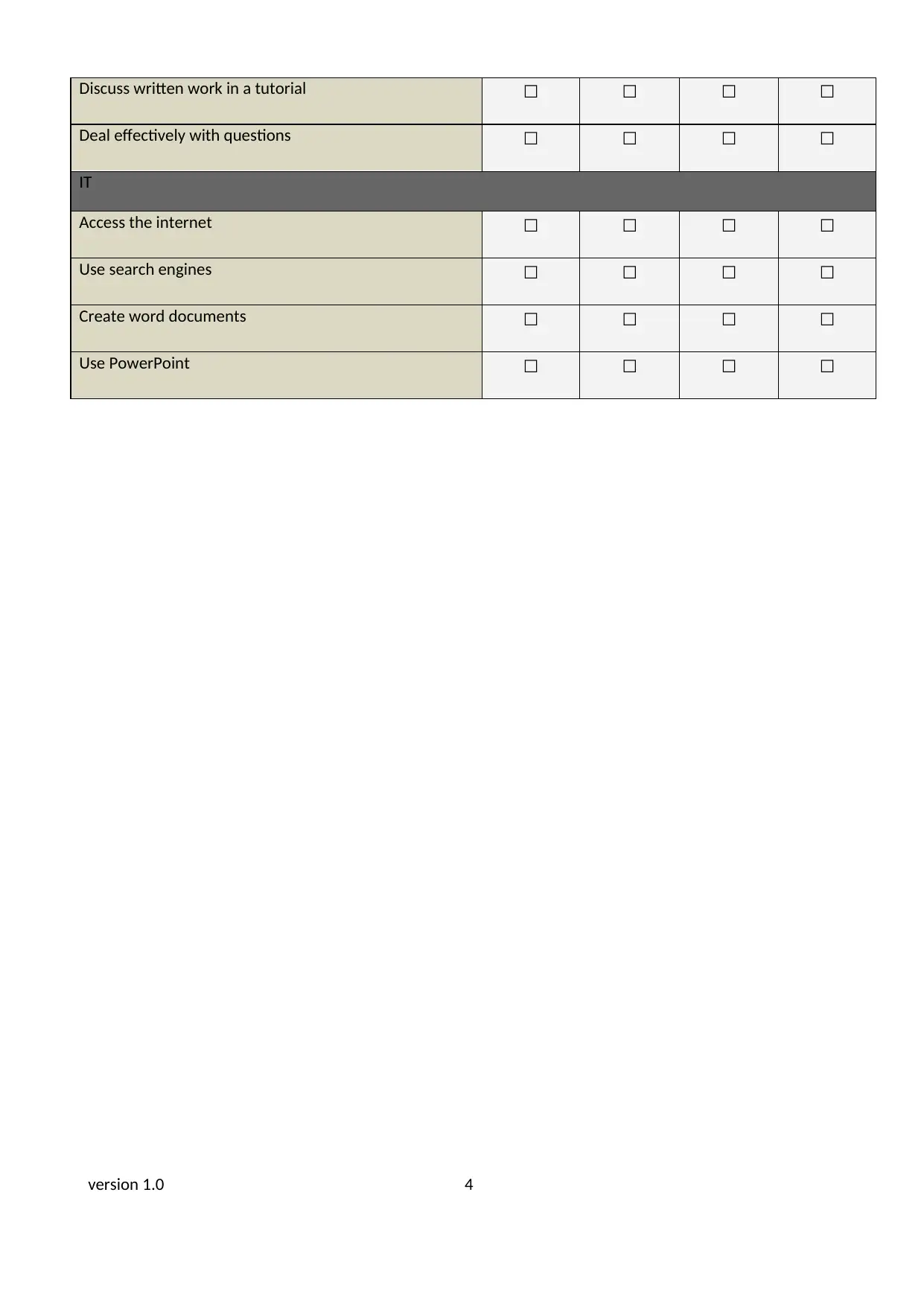
Discuss written work in a tutorial ☐ ☐ ☐ ☐
Deal effectively with questions ☐ ☐ ☐ ☐
IT
Access the internet ☐ ☐ ☐ ☐
Use search engines ☐ ☐ ☐ ☐
Create word documents ☐ ☐ ☐ ☐
Use PowerPoint ☐ ☐ ☐ ☐
version 1.0 4
Deal effectively with questions ☐ ☐ ☐ ☐
IT
Access the internet ☐ ☐ ☐ ☐
Use search engines ☐ ☐ ☐ ☐
Create word documents ☐ ☐ ☐ ☐
Use PowerPoint ☐ ☐ ☐ ☐
version 1.0 4
Paraphrase This Document
Need a fresh take? Get an instant paraphrase of this document with our AI Paraphraser
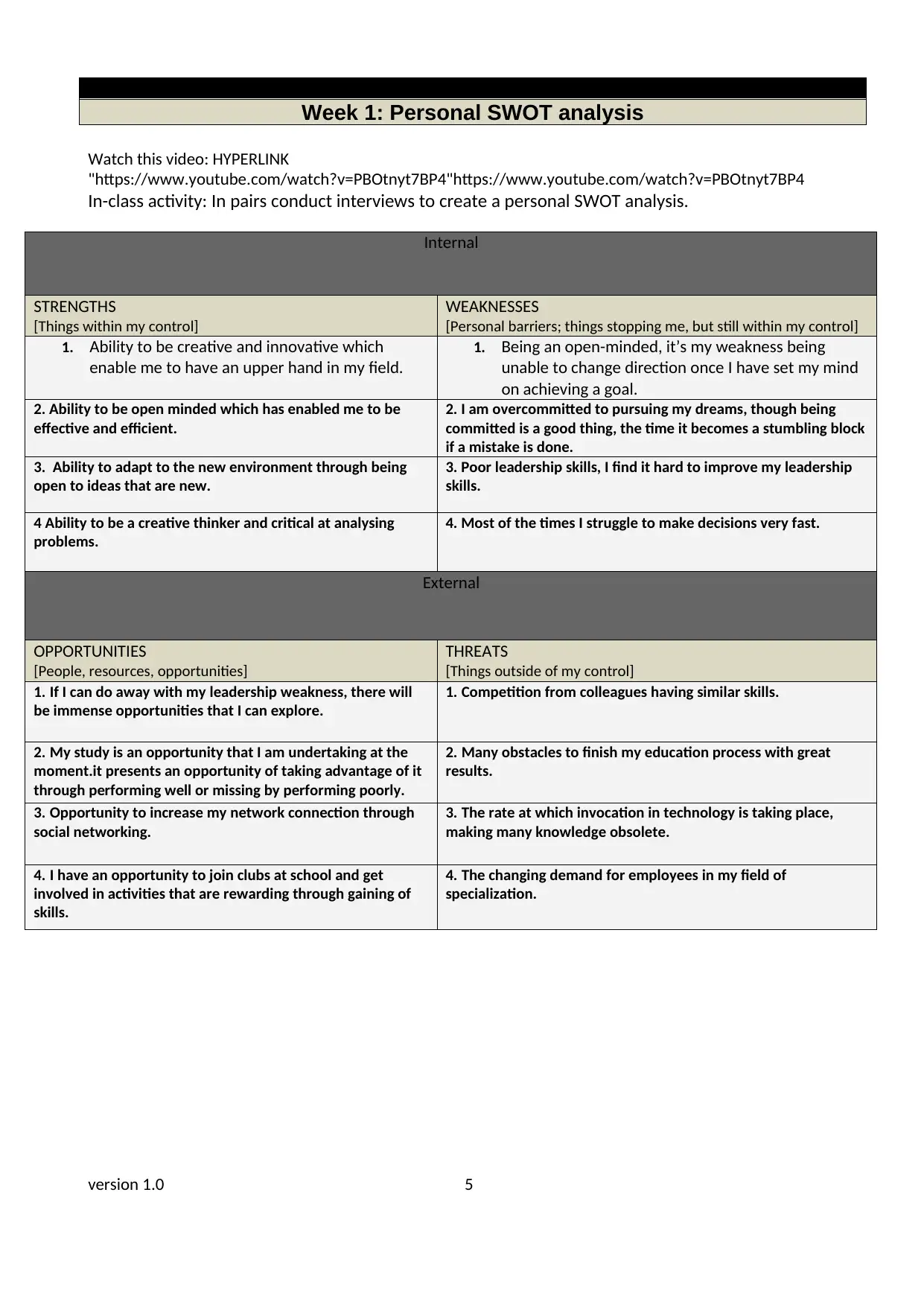
SECTION 1: PORTFOLIO EVIDENCE
Week 1: Personal SWOT analysis
Watch this video: HYPERLINK
"https://www.youtube.com/watch?v=PBOtnyt7BP4"https://www.youtube.com/watch?v=PBOtnyt7BP4
In-class activity: In pairs conduct interviews to create a personal SWOT analysis.
Internal
STRENGTHS
[Things within my control]
WEAKNESSES
[Personal barriers; things stopping me, but still within my control]
1. Ability to be creative and innovative which
enable me to have an upper hand in my field.
1. Being an open-minded, it’s my weakness being
unable to change direction once I have set my mind
on achieving a goal.
2. Ability to be open minded which has enabled me to be
effective and efficient.
2. I am overcommitted to pursuing my dreams, though being
committed is a good thing, the time it becomes a stumbling block
if a mistake is done.
3. Ability to adapt to the new environment through being
open to ideas that are new.
3. Poor leadership skills, I find it hard to improve my leadership
skills.
4 Ability to be a creative thinker and critical at analysing
problems.
4. Most of the times I struggle to make decisions very fast.
External
OPPORTUNITIES
[People, resources, opportunities]
THREATS
[Things outside of my control]
1. If I can do away with my leadership weakness, there will
be immense opportunities that I can explore.
1. Competition from colleagues having similar skills.
2. My study is an opportunity that I am undertaking at the
moment.it presents an opportunity of taking advantage of it
through performing well or missing by performing poorly.
2. Many obstacles to finish my education process with great
results.
3. Opportunity to increase my network connection through
social networking.
3. The rate at which invocation in technology is taking place,
making many knowledge obsolete.
4. I have an opportunity to join clubs at school and get
involved in activities that are rewarding through gaining of
skills.
4. The changing demand for employees in my field of
specialization.
version 1.0 5
Week 1: Personal SWOT analysis
Watch this video: HYPERLINK
"https://www.youtube.com/watch?v=PBOtnyt7BP4"https://www.youtube.com/watch?v=PBOtnyt7BP4
In-class activity: In pairs conduct interviews to create a personal SWOT analysis.
Internal
STRENGTHS
[Things within my control]
WEAKNESSES
[Personal barriers; things stopping me, but still within my control]
1. Ability to be creative and innovative which
enable me to have an upper hand in my field.
1. Being an open-minded, it’s my weakness being
unable to change direction once I have set my mind
on achieving a goal.
2. Ability to be open minded which has enabled me to be
effective and efficient.
2. I am overcommitted to pursuing my dreams, though being
committed is a good thing, the time it becomes a stumbling block
if a mistake is done.
3. Ability to adapt to the new environment through being
open to ideas that are new.
3. Poor leadership skills, I find it hard to improve my leadership
skills.
4 Ability to be a creative thinker and critical at analysing
problems.
4. Most of the times I struggle to make decisions very fast.
External
OPPORTUNITIES
[People, resources, opportunities]
THREATS
[Things outside of my control]
1. If I can do away with my leadership weakness, there will
be immense opportunities that I can explore.
1. Competition from colleagues having similar skills.
2. My study is an opportunity that I am undertaking at the
moment.it presents an opportunity of taking advantage of it
through performing well or missing by performing poorly.
2. Many obstacles to finish my education process with great
results.
3. Opportunity to increase my network connection through
social networking.
3. The rate at which invocation in technology is taking place,
making many knowledge obsolete.
4. I have an opportunity to join clubs at school and get
involved in activities that are rewarding through gaining of
skills.
4. The changing demand for employees in my field of
specialization.
version 1.0 5
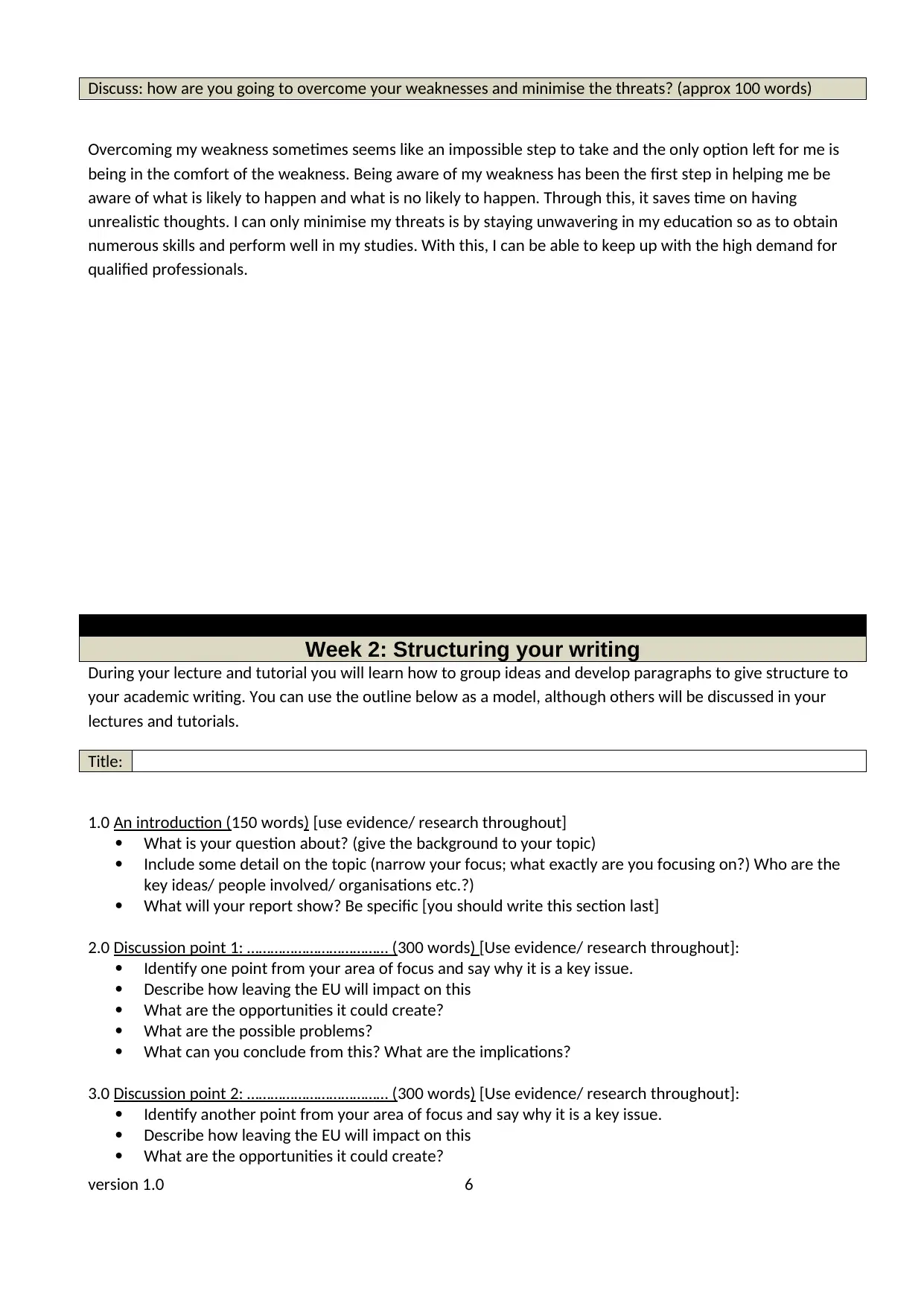
Discuss: how are you going to overcome your weaknesses and minimise the threats? (approx 100 words)
Overcoming my weakness sometimes seems like an impossible step to take and the only option left for me is
being in the comfort of the weakness. Being aware of my weakness has been the first step in helping me be
aware of what is likely to happen and what is no likely to happen. Through this, it saves time on having
unrealistic thoughts. I can only minimise my threats is by staying unwavering in my education so as to obtain
numerous skills and perform well in my studies. With this, I can be able to keep up with the high demand for
qualified professionals.
SECTION 1: PORTFOLIO EVIDENCE
Week 2: Structuring your writing
During your lecture and tutorial you will learn how to group ideas and develop paragraphs to give structure to
your academic writing. You can use the outline below as a model, although others will be discussed in your
lectures and tutorials.
Title:
1.0 An introduction (150 words) [use evidence/ research throughout]
What is your question about? (give the background to your topic)
Include some detail on the topic (narrow your focus; what exactly are you focusing on?) Who are the
key ideas/ people involved/ organisations etc.?)
What will your report show? Be specific [you should write this section last]
2.0 Discussion point 1: ……………………………… (300 words) [Use evidence/ research throughout]:
Identify one point from your area of focus and say why it is a key issue.
Describe how leaving the EU will impact on this
What are the opportunities it could create?
What are the possible problems?
What can you conclude from this? What are the implications?
3.0 Discussion point 2: ……………………………… (300 words) [Use evidence/ research throughout]:
Identify another point from your area of focus and say why it is a key issue.
Describe how leaving the EU will impact on this
What are the opportunities it could create?
version 1.0 6
Overcoming my weakness sometimes seems like an impossible step to take and the only option left for me is
being in the comfort of the weakness. Being aware of my weakness has been the first step in helping me be
aware of what is likely to happen and what is no likely to happen. Through this, it saves time on having
unrealistic thoughts. I can only minimise my threats is by staying unwavering in my education so as to obtain
numerous skills and perform well in my studies. With this, I can be able to keep up with the high demand for
qualified professionals.
SECTION 1: PORTFOLIO EVIDENCE
Week 2: Structuring your writing
During your lecture and tutorial you will learn how to group ideas and develop paragraphs to give structure to
your academic writing. You can use the outline below as a model, although others will be discussed in your
lectures and tutorials.
Title:
1.0 An introduction (150 words) [use evidence/ research throughout]
What is your question about? (give the background to your topic)
Include some detail on the topic (narrow your focus; what exactly are you focusing on?) Who are the
key ideas/ people involved/ organisations etc.?)
What will your report show? Be specific [you should write this section last]
2.0 Discussion point 1: ……………………………… (300 words) [Use evidence/ research throughout]:
Identify one point from your area of focus and say why it is a key issue.
Describe how leaving the EU will impact on this
What are the opportunities it could create?
What are the possible problems?
What can you conclude from this? What are the implications?
3.0 Discussion point 2: ……………………………… (300 words) [Use evidence/ research throughout]:
Identify another point from your area of focus and say why it is a key issue.
Describe how leaving the EU will impact on this
What are the opportunities it could create?
version 1.0 6
⊘ This is a preview!⊘
Do you want full access?
Subscribe today to unlock all pages.

Trusted by 1+ million students worldwide
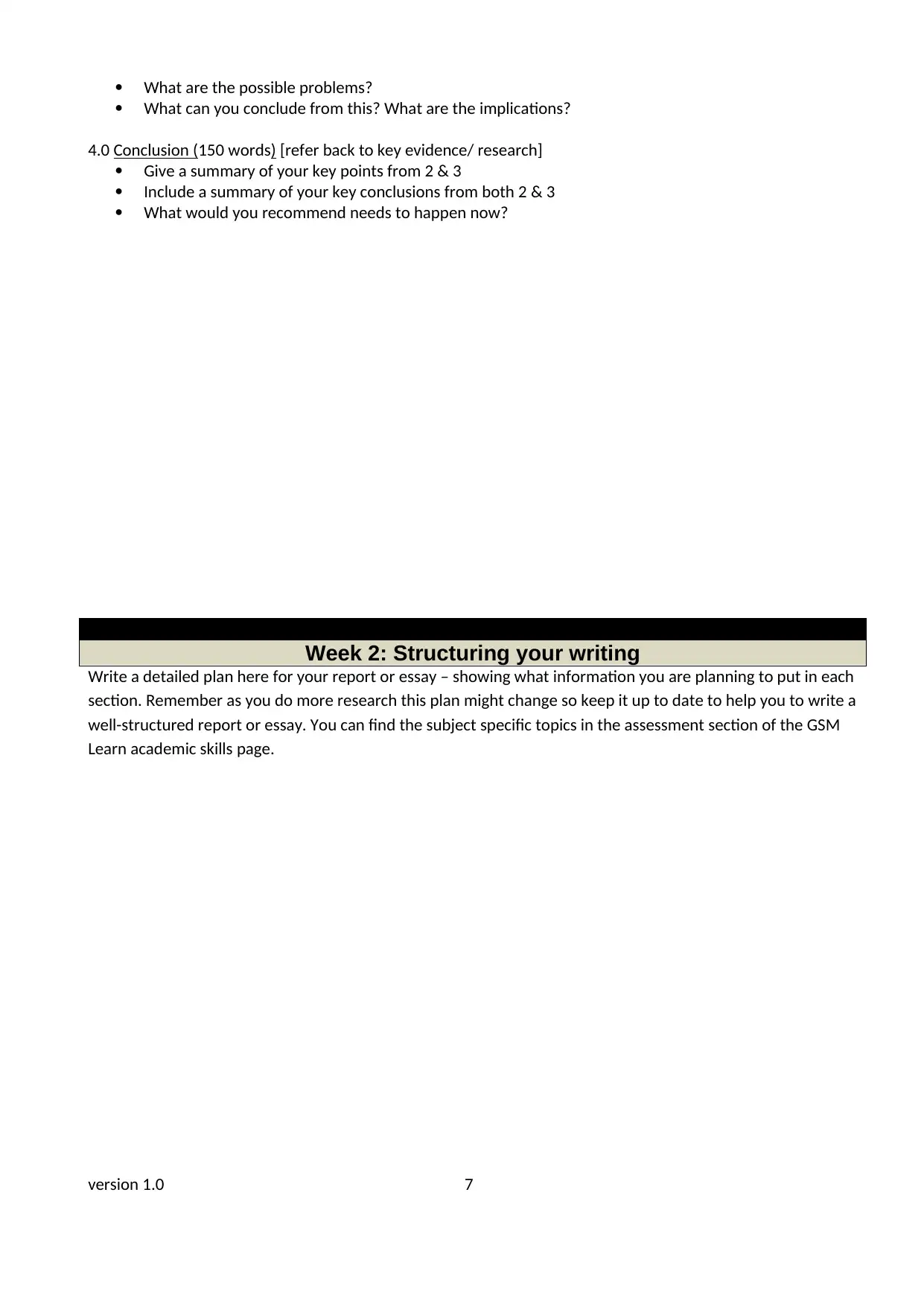
What are the possible problems?
What can you conclude from this? What are the implications?
4.0 Conclusion (150 words) [refer back to key evidence/ research]
Give a summary of your key points from 2 & 3
Include a summary of your key conclusions from both 2 & 3
What would you recommend needs to happen now?
SECTION 1: PORTFOLIO EVIDENCE
Week 2: Structuring your writing
Write a detailed plan here for your report or essay – showing what information you are planning to put in each
section. Remember as you do more research this plan might change so keep it up to date to help you to write a
well-structured report or essay. You can find the subject specific topics in the assessment section of the GSM
Learn academic skills page.
version 1.0 7
What can you conclude from this? What are the implications?
4.0 Conclusion (150 words) [refer back to key evidence/ research]
Give a summary of your key points from 2 & 3
Include a summary of your key conclusions from both 2 & 3
What would you recommend needs to happen now?
SECTION 1: PORTFOLIO EVIDENCE
Week 2: Structuring your writing
Write a detailed plan here for your report or essay – showing what information you are planning to put in each
section. Remember as you do more research this plan might change so keep it up to date to help you to write a
well-structured report or essay. You can find the subject specific topics in the assessment section of the GSM
Learn academic skills page.
version 1.0 7
Paraphrase This Document
Need a fresh take? Get an instant paraphrase of this document with our AI Paraphraser
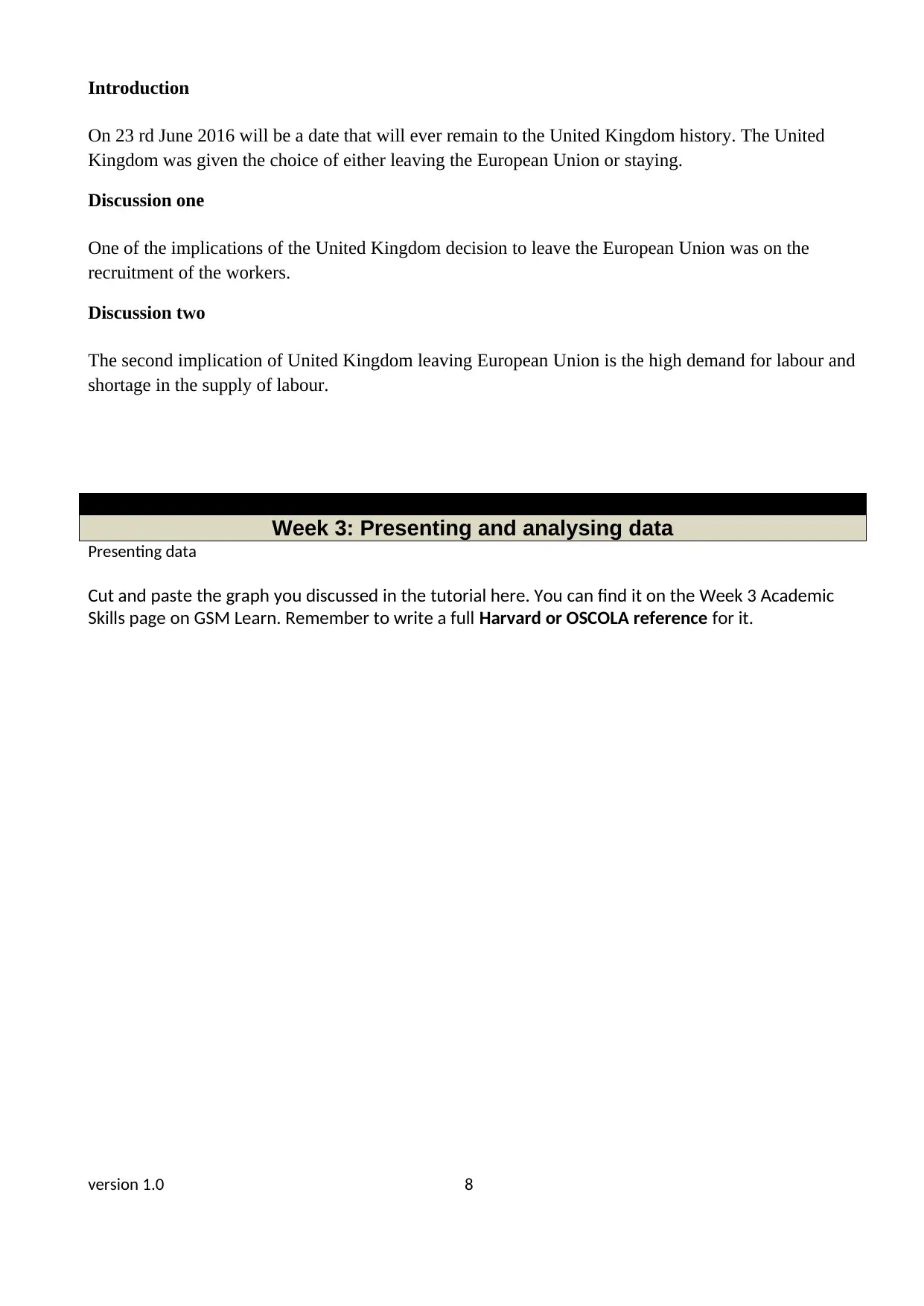
Introduction
On 23 rd June 2016 will be a date that will ever remain to the United Kingdom history. The United
Kingdom was given the choice of either leaving the European Union or staying.
Discussion one
One of the implications of the United Kingdom decision to leave the European Union was on the
recruitment of the workers.
Discussion two
The second implication of United Kingdom leaving European Union is the high demand for labour and
shortage in the supply of labour.
SECTION 1: PORTFOLIO EVIDENCE
Week 3: Presenting and analysing data
Presenting data
Cut and paste the graph you discussed in the tutorial here. You can find it on the Week 3 Academic
Skills page on GSM Learn. Remember to write a full Harvard or OSCOLA reference for it.
version 1.0 8
On 23 rd June 2016 will be a date that will ever remain to the United Kingdom history. The United
Kingdom was given the choice of either leaving the European Union or staying.
Discussion one
One of the implications of the United Kingdom decision to leave the European Union was on the
recruitment of the workers.
Discussion two
The second implication of United Kingdom leaving European Union is the high demand for labour and
shortage in the supply of labour.
SECTION 1: PORTFOLIO EVIDENCE
Week 3: Presenting and analysing data
Presenting data
Cut and paste the graph you discussed in the tutorial here. You can find it on the Week 3 Academic
Skills page on GSM Learn. Remember to write a full Harvard or OSCOLA reference for it.
version 1.0 8
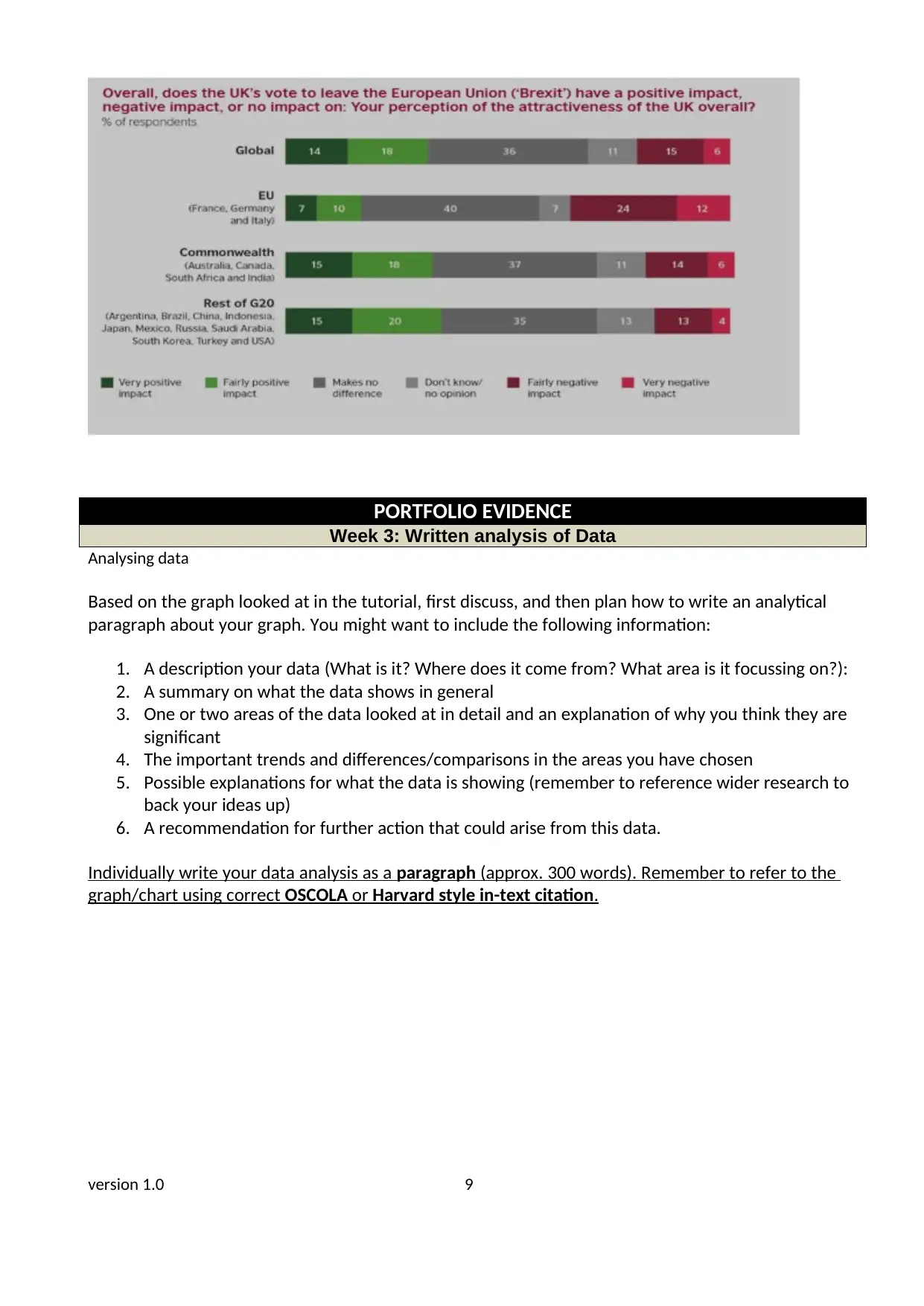
PORTFOLIO EVIDENCE
Week 3: Written analysis of Data
Analysing data
Based on the graph looked at in the tutorial, first discuss, and then plan how to write an analytical
paragraph about your graph. You might want to include the following information:
1. A description your data (What is it? Where does it come from? What area is it focussing on?):
2. A summary on what the data shows in general
3. One or two areas of the data looked at in detail and an explanation of why you think they are
significant
4. The important trends and differences/comparisons in the areas you have chosen
5. Possible explanations for what the data is showing (remember to reference wider research to
back your ideas up)
6. A recommendation for further action that could arise from this data.
Individually write your data analysis as a paragraph (approx. 300 words). Remember to refer to the
graph/chart using correct OSCOLA or Harvard style in-text citation.
version 1.0 9
Week 3: Written analysis of Data
Analysing data
Based on the graph looked at in the tutorial, first discuss, and then plan how to write an analytical
paragraph about your graph. You might want to include the following information:
1. A description your data (What is it? Where does it come from? What area is it focussing on?):
2. A summary on what the data shows in general
3. One or two areas of the data looked at in detail and an explanation of why you think they are
significant
4. The important trends and differences/comparisons in the areas you have chosen
5. Possible explanations for what the data is showing (remember to reference wider research to
back your ideas up)
6. A recommendation for further action that could arise from this data.
Individually write your data analysis as a paragraph (approx. 300 words). Remember to refer to the
graph/chart using correct OSCOLA or Harvard style in-text citation.
version 1.0 9
⊘ This is a preview!⊘
Do you want full access?
Subscribe today to unlock all pages.

Trusted by 1+ million students worldwide
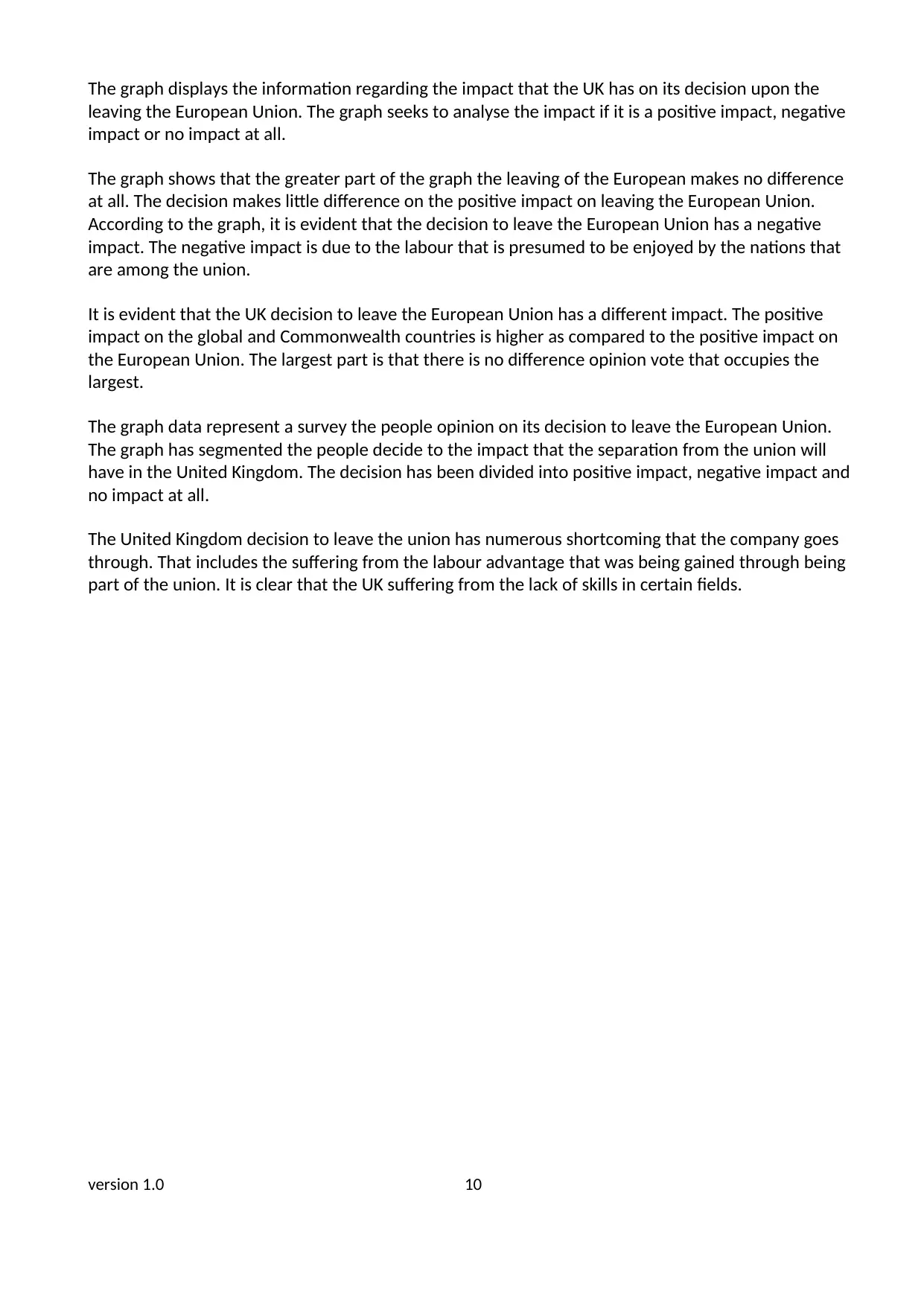
The graph displays the information regarding the impact that the UK has on its decision upon the
leaving the European Union. The graph seeks to analyse the impact if it is a positive impact, negative
impact or no impact at all.
The graph shows that the greater part of the graph the leaving of the European makes no difference
at all. The decision makes little difference on the positive impact on leaving the European Union.
According to the graph, it is evident that the decision to leave the European Union has a negative
impact. The negative impact is due to the labour that is presumed to be enjoyed by the nations that
are among the union.
It is evident that the UK decision to leave the European Union has a different impact. The positive
impact on the global and Commonwealth countries is higher as compared to the positive impact on
the European Union. The largest part is that there is no difference opinion vote that occupies the
largest.
The graph data represent a survey the people opinion on its decision to leave the European Union.
The graph has segmented the people decide to the impact that the separation from the union will
have in the United Kingdom. The decision has been divided into positive impact, negative impact and
no impact at all.
The United Kingdom decision to leave the union has numerous shortcoming that the company goes
through. That includes the suffering from the labour advantage that was being gained through being
part of the union. It is clear that the UK suffering from the lack of skills in certain fields.
version 1.0 10
leaving the European Union. The graph seeks to analyse the impact if it is a positive impact, negative
impact or no impact at all.
The graph shows that the greater part of the graph the leaving of the European makes no difference
at all. The decision makes little difference on the positive impact on leaving the European Union.
According to the graph, it is evident that the decision to leave the European Union has a negative
impact. The negative impact is due to the labour that is presumed to be enjoyed by the nations that
are among the union.
It is evident that the UK decision to leave the European Union has a different impact. The positive
impact on the global and Commonwealth countries is higher as compared to the positive impact on
the European Union. The largest part is that there is no difference opinion vote that occupies the
largest.
The graph data represent a survey the people opinion on its decision to leave the European Union.
The graph has segmented the people decide to the impact that the separation from the union will
have in the United Kingdom. The decision has been divided into positive impact, negative impact and
no impact at all.
The United Kingdom decision to leave the union has numerous shortcoming that the company goes
through. That includes the suffering from the labour advantage that was being gained through being
part of the union. It is clear that the UK suffering from the lack of skills in certain fields.
version 1.0 10
Paraphrase This Document
Need a fresh take? Get an instant paraphrase of this document with our AI Paraphraser
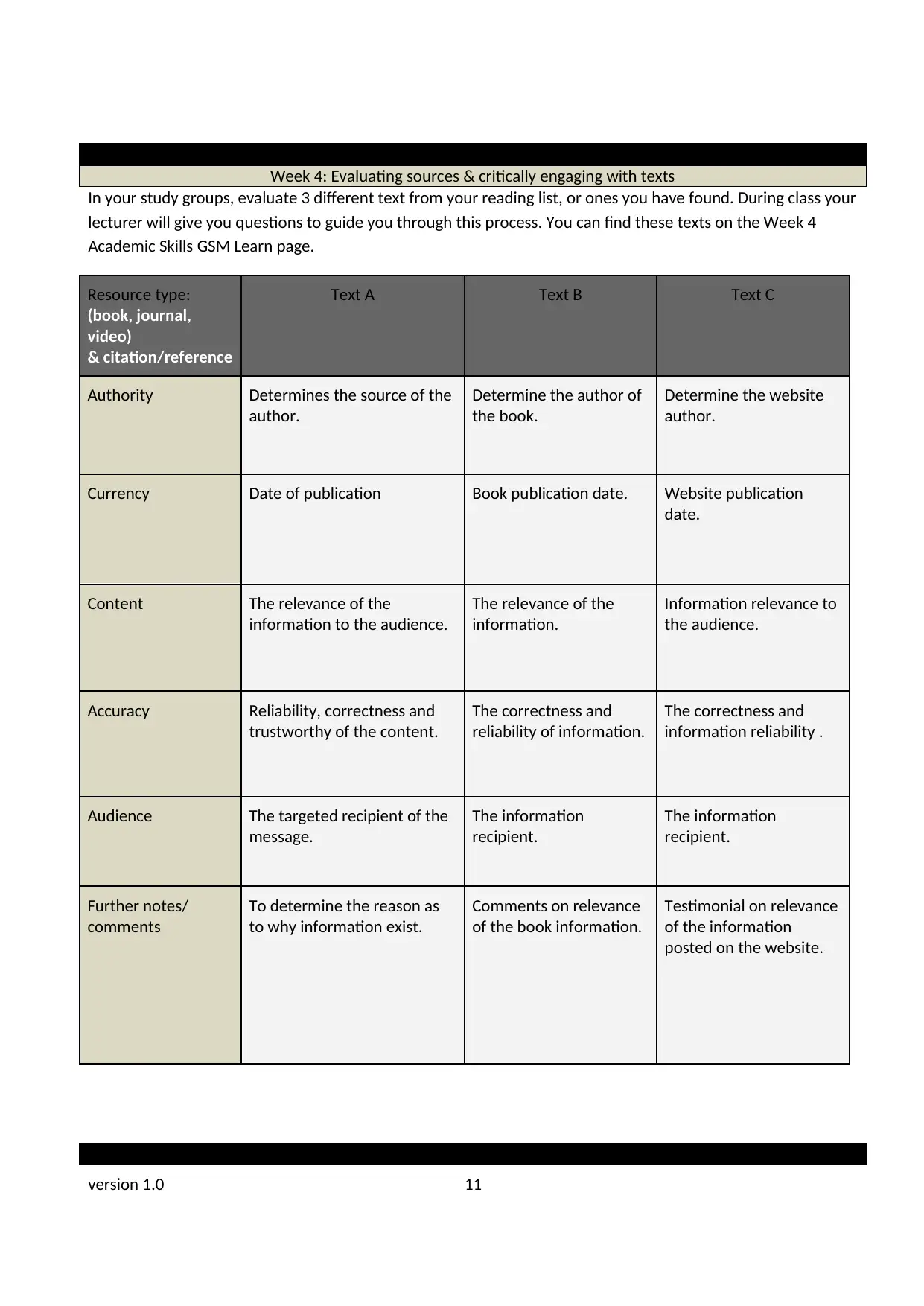
PORTFOLIO EVIDENCE
Week 4: Evaluating sources & critically engaging with texts
In your study groups, evaluate 3 different text from your reading list, or ones you have found. During class your
lecturer will give you questions to guide you through this process. You can find these texts on the Week 4
Academic Skills GSM Learn page.
Resource type:
(book, journal,
video)
& citation/reference
Text A Text B Text C
Authority Determines the source of the
author.
Determine the author of
the book.
Determine the website
author.
Currency Date of publication Book publication date. Website publication
date.
Content The relevance of the
information to the audience.
The relevance of the
information.
Information relevance to
the audience.
Accuracy Reliability, correctness and
trustworthy of the content.
The correctness and
reliability of information.
The correctness and
information reliability .
Audience The targeted recipient of the
message.
The information
recipient.
The information
recipient.
Further notes/
comments
To determine the reason as
to why information exist.
Comments on relevance
of the book information.
Testimonial on relevance
of the information
posted on the website.
PORTFOLIO EVIDENCE
version 1.0 11
Week 4: Evaluating sources & critically engaging with texts
In your study groups, evaluate 3 different text from your reading list, or ones you have found. During class your
lecturer will give you questions to guide you through this process. You can find these texts on the Week 4
Academic Skills GSM Learn page.
Resource type:
(book, journal,
video)
& citation/reference
Text A Text B Text C
Authority Determines the source of the
author.
Determine the author of
the book.
Determine the website
author.
Currency Date of publication Book publication date. Website publication
date.
Content The relevance of the
information to the audience.
The relevance of the
information.
Information relevance to
the audience.
Accuracy Reliability, correctness and
trustworthy of the content.
The correctness and
reliability of information.
The correctness and
information reliability .
Audience The targeted recipient of the
message.
The information
recipient.
The information
recipient.
Further notes/
comments
To determine the reason as
to why information exist.
Comments on relevance
of the book information.
Testimonial on relevance
of the information
posted on the website.
PORTFOLIO EVIDENCE
version 1.0 11
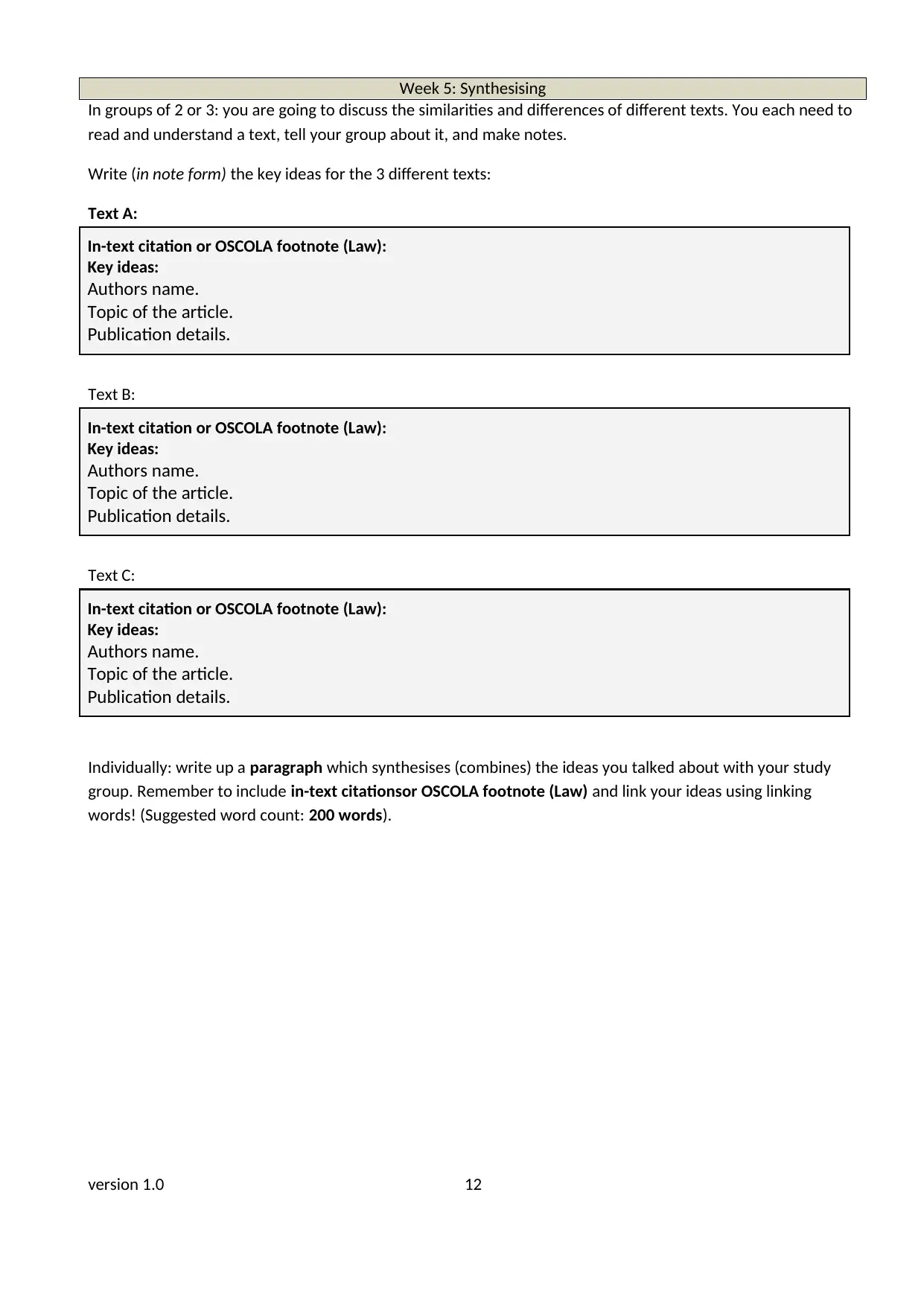
Week 5: Synthesising
In groups of 2 or 3: you are going to discuss the similarities and differences of different texts. You each need to
read and understand a text, tell your group about it, and make notes.
Write (in note form) the key ideas for the 3 different texts:
Text A:
In-text citation or OSCOLA footnote (Law):
Key ideas:
Authors name.
Topic of the article.
Publication details.
Text B:
In-text citation or OSCOLA footnote (Law):
Key ideas:
Authors name.
Topic of the article.
Publication details.
Text C:
In-text citation or OSCOLA footnote (Law):
Key ideas:
Authors name.
Topic of the article.
Publication details.
Individually: write up a paragraph which synthesises (combines) the ideas you talked about with your study
group. Remember to include in-text citationsor OSCOLA footnote (Law) and link your ideas using linking
words! (Suggested word count: 200 words).
version 1.0 12
In groups of 2 or 3: you are going to discuss the similarities and differences of different texts. You each need to
read and understand a text, tell your group about it, and make notes.
Write (in note form) the key ideas for the 3 different texts:
Text A:
In-text citation or OSCOLA footnote (Law):
Key ideas:
Authors name.
Topic of the article.
Publication details.
Text B:
In-text citation or OSCOLA footnote (Law):
Key ideas:
Authors name.
Topic of the article.
Publication details.
Text C:
In-text citation or OSCOLA footnote (Law):
Key ideas:
Authors name.
Topic of the article.
Publication details.
Individually: write up a paragraph which synthesises (combines) the ideas you talked about with your study
group. Remember to include in-text citationsor OSCOLA footnote (Law) and link your ideas using linking
words! (Suggested word count: 200 words).
version 1.0 12
⊘ This is a preview!⊘
Do you want full access?
Subscribe today to unlock all pages.

Trusted by 1+ million students worldwide
1 out of 28
Related Documents
Your All-in-One AI-Powered Toolkit for Academic Success.
+13062052269
info@desklib.com
Available 24*7 on WhatsApp / Email
![[object Object]](/_next/static/media/star-bottom.7253800d.svg)
Unlock your academic potential
Copyright © 2020–2025 A2Z Services. All Rights Reserved. Developed and managed by ZUCOL.





